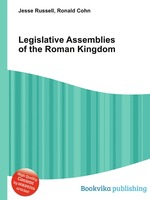Legislative Assemblies of the Roman Kingdom
Jesse Russell Ronald Cohn
бумажная книга
High Quality Content by WIKIPEDIA articles! The Legislative Assemblies of the Roman Kingdom were political institutions in the ancient Roman Kingdom. While one assembly, the Curiate Assembly, had some legislative powers, these powers involved nothing more than a right to symbolically ratify decrees issued by the king. The functions of the other assembly, the Calate Assembly, were purely religious. During the years of the kingdom, the People of Rome were organized on the basis of units called Curia. All of the People of Rome were divided amongst a total of thirty Curia, and membership in an individual Curia was hereditary. Each member of a particular family belonged to the same Curia. Each Curia had an organization similar to that of the early Roman family, including specific religious rites and common festivals. These Curia were the basic units of division in the two popular assemblies. The members in each Curia would vote, and the majority in each Curia would determine how that Curia voted before the assembly. Thus, a majority of the Curia (sixteen out of the thirty total Curia) were needed during any vote before either the Curiate Assembly or the Calate Assembly.


